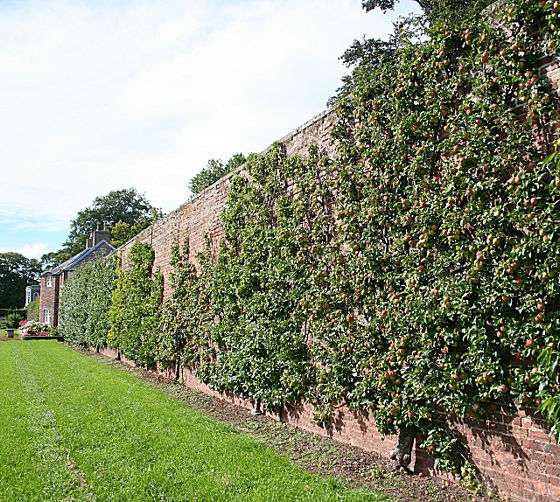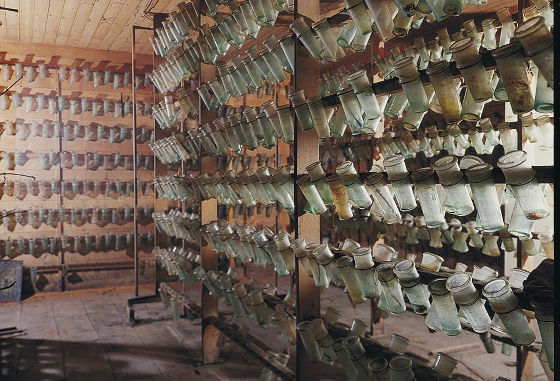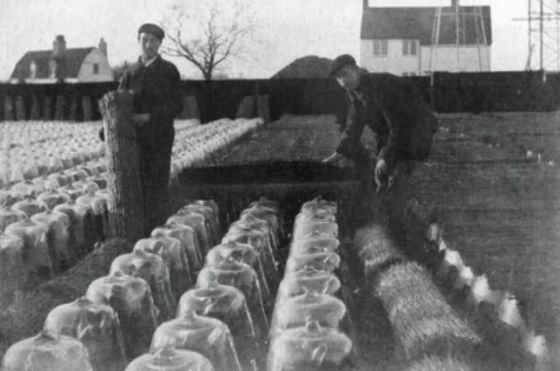Agriculture "Fruit · Wall" using the walls in the street that had been done in the 1600s

When cultivating crops in cold regions and in times, in modern times plastic houses and greenhouses are used. However, in the medieval period before the vinyl house was invented, a method was adopted in which walls were built in the streets and the crops were raised with the heat of the sunlight absorbed by the walls. Sometimes the wall became a maze, the farming law that the enemy army invaded was so confused "Fruit · Wall"is.
LOW-TECH MAGAZINE: Fruit Walls: Urban Farming in the 1600s
http://www.lowtechmagazine.com/2015/12/fruit-walls-urban-farming.html
The reason why the fruit wall was created was that, in 1561, Swiss botanist Conrad Gesner said "It is effective to use walls warmed by the sun in order to make maturity and currant ripe" What you mentioned in the book. Gesner's view extends to Northern Europe such as North France, the UK, Belgium, the Netherlands as "Fruit Wall".

The mechanism of fruit · wall is "Walls that became warm by daylight sunshine improve the growth environment of plants, slowly release heat even at night, reducing the negative effects of cold." It seems that roofs and canopies were sometimes installed in these fruit · walls to protect the plants from rain, hail, honey of birds etc etc.
From the mid-14th century to the mid-19th centurySmall ice ageIt was called cold environment continued. It was during this time that fruit · walls were created, it was the first time in France to take advantage of fruit · wall technology to surpass cold, he said that he started planting plants along the wall side.

Even now European architecture, one wall is covered with ivy and fruit tree "EspariyeAlthough I often see España, it was exactly the two-bird way to make fruit growing well while efficiently using space. At this time, the technology was improved more and more, such as "firmly rooting and planting should be planted slightly away from the wall to improve the circulation of the air".
Fruit Wall was initially seen in areas where many wealthy people live, such as Versailles, but technology has also spread to the region, later Montreuil outside of Paris will be known for the production of large peaches by fruit walls . In the Montreuil around 1870 Mr. 600 km of fruit walls were formed and the town became like a maze and the Prussian army trying to invade was confused and did not proceed well.

The height of the wall at this time is 2.5 to 3 meters, the thickness is about 50 cm. The surface was painted with plaster of limestone. Apples, raspberries, vegetables, flowers, etc were raised because the temperature of the fruit · wall is somewhat low. Montreuil was originally a peach production area, but in the peak period it is now possible to produce as many as 17 million high quality fruits of various kinds annually.
In 1730, similar to Montreuil, the city succeeded in producing fruits by fruit walls, a town in the southwest of Paris. In Tomri the production of grapes is famous, and 300 km of fruit walls were made in the peak. The grape growing requires a temperate and dry environment, but in the southern part of Paris it is exposed to rain and humid winds, so the southeastern part was for it.
In Tomri, in addition to fruit · wall, fruit storage technology was greatly improved, and a method to set a lot of bottles containing water and grape stalk on the shelf was also devised. This seems to keep the freshness of grapes.

Besides this, cultivation of grapes using fruit walls was done even in lowlands such as the Netherlands and Belgium. Since the 1850's Westland in the Netherlands and Fuilaart in Belgium have established a fruit wall covering 178 km as the production area of grapes.
The fruit wall of the Netherlands is a winding design with such a feeling.

In addition, it seems there was also a fruit wall in the shape that it was decorated.

One of the reasons the wall was designed to be decorated is to increase the strength. Also, because the Netherlands is located about 400 km north of Paris, winding walls that can keep higher temperatures than straight walls have been useful.
Also, Swiss mathematician Nicolas Fatio designed a wall with a 45 degree slope to allow for sunlight for a longer time.

Large-scale farming using fruit walls in the UK was not conducted, but since 1600,Country houseIn the garden of course, fruit · walls are now being used. In the case of the UK, the inside of the wall is a hollow, warming the wall by generating a fire inside, and developing a mechanism that smoke is discharged from the chimney at the top of the wall. Also, there seemed to be a type of fruit wall that can be warmed by a hot water pipe.

However, in the latter half of the nineteenth century, as railroads develop and it becomes easier to import fruits from the southern region, fruit · walls which cost labor costs will decline. The cost of importing by rail was cheaper than raising on our own.
Although we will talk a little bit, the reason why the construction of the "greenhouse" seen in modern times in the Middle Ages has not progressed quite a bit is because it was difficult to produce a huge glass sheet. On the other hand, greenhouses making use of a method of placing a bottomless bell-shaped glass on a plant and keeping the temperature inside the glass high will be around the 1600s.

In the 1800 's, cultivators of the Netherlands and Belgium found that growing plants improves by placing glass plates in a way that they stand against fruit walls. And gradually improving the technology, around 1850 the first time in the Westland region of the Netherlands using the fruit wall in the form of building a greenhouse, around 1881 about 22 km of the 178 km of fruit · walls glass It is said that it was covered with.

After that, although the structure of the greenhouse steadily developed, the essential "warmth" mainly consists of a structure of fruit / wall, that is, it is warmed by daylight sunlight, and gradually releases heat during the night I took in it. When the temperature goes low, such as during the night and cloudy days, an insulating mat was installed and functioned like a modern solar system.

As the industry gradually developed, it became possible to produce a huge glass plate, and it became possible to keep warmth efficiently with fossil fuel, and in 1890, the greenhouse using the large glass was made for the first time in Belgium , The Netherlands also follows it. Then,Thermal massThe fruit · wall which can be said to be the originator of the disappeared like a substitute for the greenhouse.

Currently, there are about 800,000 hectares of passive solar type greenhouses that do not use power to use sunlight in China. Greenhouse technology developed in the Netherlands based on fruit · wall developed in France is now used all over the world and greenhouse about 80 times the greenhouse in the Netherlands spreads to China.

Related Posts:







